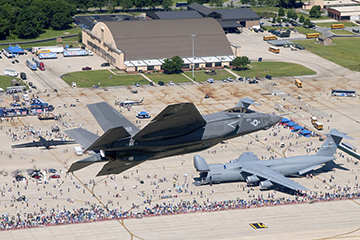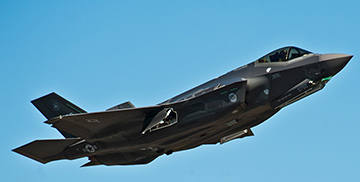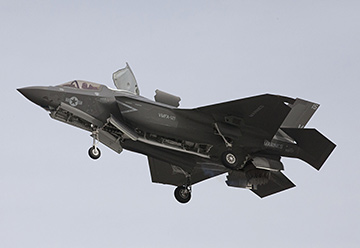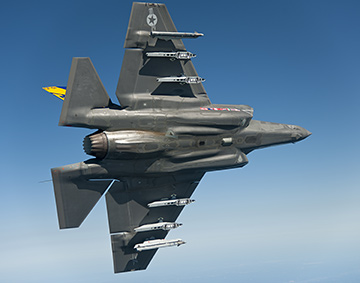 U.S. Navy photo by Andy Wolfe courtesy of Lockheed Martin An F-35C Joint Strike Fighter flies over Andrews Air Force Base, Md., during its 2011 air show. |
Second of five articles
The cost of an F-35 is currently increasing, more than likely to remain high, and very unlikely to even approach the low levels being articulated by Pentagon managers and documents.
But F-35 costs are clouded by the calculating ways that the Pentagon reports them.
The applicable empirical data—the most informative—have been obscured. They also call into question the long-range projection just made by the Defense Department in its new Selected Acquisition Report that total program costs for the F-35 will come down by $4.5 billion.
The detailed F-35 SAR, made available by the Project on Government Oversight last week, is widely viewed as the gold standard of a weapon program’s cost.
It measures the F-35’s cost in three different ways:
• The Program Acquisition Unit Cost (PAUC) divides the total acquisition expense, including research and development (R&D), procurement and military construction funds, by the total number of planned test and operational aircraft (2,457).
The result is stated in either “base-year” ($319 billion) or “then-year” ($391 billion) dollars. Base-year dollars means every dollar in a multi-year program is adjusted to match the inflation value for the year when the program was last “restructured” to address cost and performance problems. In the case of the F-35, the base year is currently 2012. Then-year dollars (also called current-year dollars) are the amounts actually appropriated or expected to be appropriated in the future; they are adjusted to whatever inflation value that pertains to the year they are appropriated.
 Air Force photo The Air Force F-35A |
Base year dollars are often preferred by advocates because they usually allow reporting a lower number (and, by implication, cost) than if mostly future, inflated (“then year”) dollars are used.
The base-year PAUC for the F-35 is $108.2 million; the then-year PAUC is $133.0 million.
Except for one small thing: those sums do not include the engine. The Pentagon, in an unusual move, broke the program into two pieces – airframe and engine – beginning in 2011. If you want a fighter with an engine, add $21.8 million for the base-year PAUC and $26.2 million for the then-year PAUC. That makes the actual Program Acquisition Unit Cost for each F-35 (with an engine) $130.0 million in obsolete 2012 dollars or $159.2 million in actual appropriations, past, present and future.
• If using base-year dollars results in a unit-cost calculation that is embarrassingly high, or if you want to know just the fabrication costs of an F-35 (not also the costs to research, design, test and house it), the SAR also calculates the Average Procurement Unit Cost (APUC). This divides the total F-35 procurement budget (i.e. not including R&D and Military Construction) by the number of operational aircraft actually to be fielded (2443). Once again, you have to add in the separately accounted engine.
 Marine Photo The Marine F-35B |
The F-35 APUC (with an engine) is $104.8 million in base-year (2012) dollars and $135.7 million in then-year (actual appropriation) dollars.
• But for some, even the base year APUC totals for the F-35 are still too high; $100-million-plus price tags can hurt any marketing plan. But not to worry: the SAR also lists something called Unit Recurring Flyaway (URF) costs. But, as the SAR does not tell you even in its small print, the URF does not include the support and training equipment, technical data, initial spare parts or even the gas and lubricants to make an F-35 useable. It also does not include the upgrades and fixes that testing and other flying experience reveals to be needed.
Bottom line: the unit recurring flyaway cost will not get you an F-35 you can fly away, not for combat, not for training, not even for the delivery hop.
A favorite of F-35 lobbyists and marketers, the URF for the F-35 aircraft is $65.9 million. Want an engine? Make it $76.8 million; that’s in base year dollars; the SAR doesn’t do the calculation in the slightly higher then-year dollars. Moreover, that ridiculously understated $76.8 million is only for the Air Force’s A version; the pricier C model for the Navy has a URF (with engine) of $88.7 million, and the Marines’ B model (with engine and lift fan) is $103.6 million.
Lockheed, among other interested parties, likes to cite the URF, but no flyable, useable F-35 in any operable force will ever be bought for that amount of money. URF unit costs are pure hogwash.
In fact, the average F-35 unit cost will be more than the $135.7 million then-year APUC, and it will even be more than the $159.2 million then-year PAUC. Those numbers are grounded in analytical quicksand.
- First, the PAUC’s numbers depend on amortizing $55.2 billion then-year dollars of R&D across the officially predicted production of 2,457 F-35 units. It is an extremely enthusiastic expectation that the numbers produced will remain that high: the planned number has already come down from 2,866, and as Pentagon insiders and critical outside observers routinely predict, they will come down further—as actual costs, to be discussed later, sink in, and as the top line of the total defense budget comes down.
- Second and more importantly, both the PAUC and the APUC projections depend on an assumed “learning curve” that shrinks unit cost for each future F-35 produced based on assumptions of improved efficiency and economies of scale. This is supposed to occur as repetitive production-line experience builds up after the design stabilizes and procurement lots double and even triple: for example from the 29 scheduled to be produced in 2013 to 100 in 2018 and 120 in 2021—even more if you add in foreign purchases.
The problem is that 60 years of actual U.S. military aircraft cost histories almost invariably show, the learning-curve efficiencies never occur as predicted. This has been reported in great detail by the extremely thorough and astute observations on weapons cost from Pentagon insider Chuck Spinney in various papers, including Defense Death Spiral, Plans/Reality Mismatch, and his final testimony to Congress.
As Spinney explains, the military aircraft’s design never actually stabilizes, even after full-rate production starts, to permit the level of repetitive-action learning anticipated on the assembly line, as is the case with automobiles. At the Pentagon, other factors—the need to redesign and fix a progression of problems brought to light during tests and operations, a constant stream of add-ons imposed by the procuring bureaucracy, plus unforeseen economic and budgetary changes—mean that learning efficiencies and economies of scale never are as optimistic as initially predicted.
Case in point: we have just seen one example of unanticipated budget changes in the form of the reductions mandated by the Budget Control Act. The one prediction you can rely on is that the learning curve never bends as sharply as projected.
As a result, unit costs remain significantly higher than projected. Predictably, to “save money” and fit under budget limits, production lots are reduced—causing even more growth in per-plane costs. This recurring phenomenon is a major component of the so-called “death spiral,” conventional wisdom that sprung directly from Spinney’s work.
A newly-leaked report from the Pentagon’s Deputy Assistant Secretary for System Engineering (DOD’s top developmental tester) strongly intimated the inability of the F-35 program to meet learning curve expectations. The annual report, released by Inside Defense and others, reported various reasons for production delays, resulting higher unit costs. It said “the program has yet to demonstrate its ability to meet yearly production goals,” as numerous manufacturing processes were not meeting efficiency targets due to the type of disruptions in production described above.
As a result of all this, another twist in the “death spiral” for the F-35 has just occurred.
In the SAR released last year, the F-35 program office projected production to ramp up to 110 units in 2018 and 130 in 2021 for the Air Force, Marines and Navy. But the new SAR quietly reduced the 2018 buy to 100 aircraft and the 2021 buy to 120 (the reductions came in the Navy buy). While representing only a 9% reduction for 2018, for example, it would nonetheless create a ripple of some as-yet undetermined cost growth in 2018 and, therefore, boost both the APUC and the PAUC for the entire fleet.
However, both the APUC and PAUC for the F-35 in the new SAR are lower than they were in last year’s report. The Pentagon’s logic suggests that as the economy of scale worsens, other factors intervene to bend the learning curve in a taxpayer-friendly way. As one observer with several decades of experience in weapons-cost growth remarked to me on the inevitability of the “death spiral” for the F-35: “And so it begins.”
 Navy photo The Navy F-35C |
There are other questionable numbers in the 2013 SAR. The total—36-year—program acquisition cost is predicted to be $4.5 billion lower: decreasing from $395.7 estimated in 2012 to $391.2 estimated this year. As the new SAR explains in a section titled “Cost Variance,” some costs went up (eg. airframe production costs increased by $1.2 billion) and others went down (eg. estimated initial spare parts for the Navy dropped by $408 million), to yield the net $4.5 billion decline.
However, the nature of some of the estimates raises serious questions.
Inflation (“Revised escalation indices. [Economic]”) estimated all the way out to the year 2037 is predicted to have increased from last year for airframe and engine production by a net combined $5.0 billion. On the other hand, that amount is more than offset by predicted savings in prime and subcontractor labor rates of $7.9 billion, again out to the year 2037, and—strangely—the reduced labor costs are predicted only to occur in aircraft fabrication, not in engine production.
That such fantastically long-term estimates are recalculated—apparently selectively—from year to year gives a false impression of precision. In fact, the SAR expressly states “we project that it is equally likely that the estimates will prove too low or too high for execution of the program described.”
Yet while the Defense Department professes an equal probability for being too high as too low, we know what the inevitable historical pattern is—and it is not for today’s cost estimates to be too high.
In any case, to declare a $4.5 billion cost reduction—based largely on predicted labor rates in one sector of the aviation industry up to 25 years in advance—calls the validity of the prediction into serious question.
To predict a labor market being $7.9 billion lower than that predicted just one year ago suggests that such estimates can be produced on demand by simply tweaking a computer model, rather than exercising caution in anticipating the ultimate cost of a program that has already proven extremely problematic and subject to more increases than decreases.
In addition to having this optimistic bias toward the future, the SAR also exercises a dubious view of the past. It assumes $1.1 billion in savings based on “revised airframe and subcontractor estimates that incorporate the latest actual costs from early Low Rate Initial Production (LRIP) lots.” However, specific contract data and empirical annual cost data, which we’ll tackle later, show those LRIP lots have been increasing in cost, not decreasing. An article at defense-aerospace.com cogently explains some of these issues.
So there you have it: PAUCs based on unachievable production numbers, APUCs derived from learning curves that never happen, URFs that assume that purchasers want to buy airplanes they cannot operate, prices translated into obsolete dollars, convenient declarations of savings to be realized 25 years from now, predictions proclaimed to be as reliable as a coin flip.
These and other dodges add up to a snake pit of misinformation about what an F-35 costs—past, present and future.
If the most authoritative document on F-35 unit costs has serious flaws, what data can objective observers rely on? Fortunately, the Pentagon comptroller’s shop publishes a more reliable annual series of reports that provides more accurate insight on what an F-35 actually costs.
We’ve just wrapped up the F-35 forest following this two-day survey of its trees. We’ll spend the next couple on our hands and knees, digging amid the cost-accounting weeds. Be ready to get your hands dirty.
Part 1: The Era of Good F-35 Feelings
Part 2: Alphabet Soup: PAUCs, APUCs, URFs, Cost Variances and Other Pricing Dodges
Part 3: The Deadly Empirical Data







